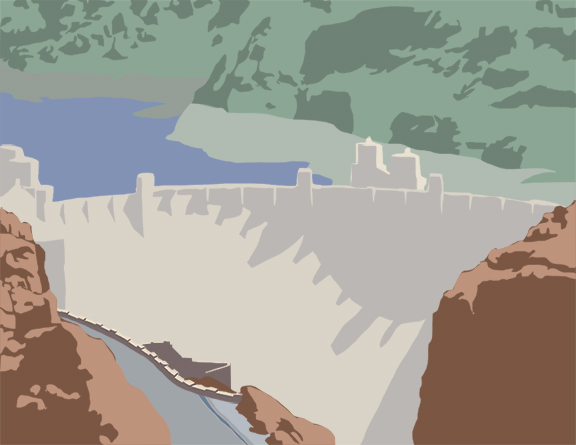Since the early 1900’s, the U.S. government had an eye on the Black Canyon, situated on the border between Nevada and Arizona.
The Black Canyon was a potential site to build a dam that would provide flood control, irrigation, and hydroelectric power to the nearby regions, but it wasn’t until 1928 that congress authorized the project. Despite being the middle of the Great Depression, construction on the Boulder Dam (what would eventually become known as the Hoover Dam) began in 1931 and was completed in 1936.
The project was contracted out to a consortium called Six Companies Inc., which was formed from eight smaller general contractors for the specific purpose of submitting a bid for the Hoover Dam contract. Despite what it seems like, the consortium didn’t exclude two of the companies out of the name, the “Six” in Six Companies Inc. is an allusion to Chinese Six Companies (A.K.A. the Chinese Consolidated Benevolent Association) where Chinese Tongs in California would take their grievances.
The design of the dam itself was a bit of a gamble, as the theories behind the engineering appeared sound on paper but had never been applied practically, meaning that the engineers behind the project had no model with which to base their work. To ensure that their designs would hold up against the immense pressure of 45,000 pounds per square foot coming from the reservoir behind it (at maximum capacity), the engineering team decided to create a dam in the shape of a horizontal arch with the curve facing upstream. The idea was that the weight of the concrete and the strength of the arch would add extra resistance to the push of the water against the dam.
Before the Hoover Dam was built, the world’s largest dam was the Owyee Dam in Oregon, which measured 420 feet high. The Hoover Dam stands at 726 feet tall weighing in at 6.5 million tons, making it one of the largest dams in the Western world to this day. Its gravity-arch design has informed and inspired many other projects, providing verification when it comes to structural theories and procedures in the construction of massive structures.
Another area of innovation was that of the methods used to cool the concrete. Normally, when pouring large blocks of concrete the mixture of water, crushed stone, sand and cement gives off a lot of heat, which causes expansion and can lead to cracks and breaks as it dries. To avoid this, the concrete needs to be cooled, but due to the large scale of the project it was estimated that it may take around 100 years for the large blocks used in the dam to fully cool if allowed to do so by normal exposure to the air, drying this way can also lead to uneven drying which causes issues with structural stability that the project (and the people downstream) could not afford. To cool the blocks more rapidly and evenly, the engineers embedded a series of 1-inch pipes inside and circulated ice water through the pipes. Tom Gailey, manager of visitor services at the dam, was quoted as describing this as the “world’s largest refrigerator, capable of making 1,000 tons of ice a day.”

